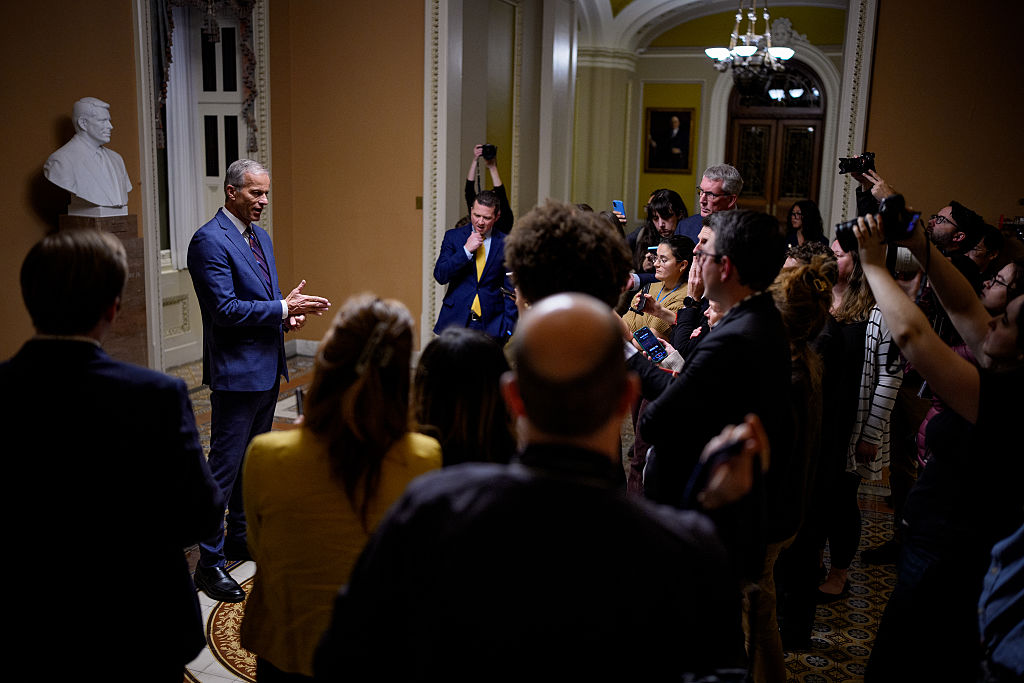Michael Gough is director of science and risk studies at the Cato Institute, where he has worked since 1996. Trained in molecular biology with a Ph.D. from Brown University, Gough began his career in environmental health and risk assessment at the congressional Office of Technology Assessment in 1975.
In the 1980s, Gough chaired a Department of Veterans Affairs advisory committee on health care for Vietnam-era veterans and the Department of Health and Human Services committee that advised the U.S. Air Force about health studies of Air Force personnel who sprayed Agent Orange in Vietnam.
Gough is the author of nearly two dozen papers in molecular biology and genetics, some fifty papers about environmental health and risk assessment, and Dioxin, Agent Orange, published by Plenum in 1986. He is co-editor with T.S. Glickman of Readings in Risk (Johns Hopkins University Press, 1990).
Cohen: EPA Administrator Carol Browner regularly touts her agency’s commitment to and successes in protecting the environment. Are her claims justified?
Gough: The environment has been getting cleaner. There’s no doubt about that. But there’s also no doubt that the environment was getting cleaner before EPA was established in 1970.
Levels of pollutants in the air and water were going down before EPA, and they’ve continued downward at the same rate since EPA came into existence. The argument can be and is made that the levels of pollutants would have leveled out or even increased if EPA hadn’t come along. That can’t be disproved, but I find it difficult to believe.
As the country has gotten richer, industry and individuals have had more money to spend on the environment. To the extent that EPA imposes a drain on economic growth–and there’s no question that it does–it’s probably retarding cleanup.
Cohen: What about the suggestion that EPA’s efforts have had a positive effect on the public health?
Gough: EPA has little, maybe nothing, to do with public health.
Until the last few years, the agency’s primary mission has been to chase around identifying toxic chemicals through laboratory tests. Then it used those tests as the basis for estimating human effects that might occur at exposure levels hundreds and thousands of times below the levels tested in animals. Based on those estimates, the agency regulates exposures or suggests that exposures be limited to certain levels.
Has all that had any effect on human health? Almost certainly not, but we have to be fair. No one can be sure. The numbers of diseases that are estimated to result from environmental exposures are so low that they can’t be distinguished from the far larger numbers of the same diseases that result from all causes. The risks are below the capacity of science to measure.
Just as no one can identify the diseases that EPA estimates to result from environmental exposures, there is no way to know if EPA’s actions have had any effect on disease rates.
Cohen: So we’re spending an awful lot of time, money, and talent chasing phantom risks. Won’t society as a whole pay for these distorted priorities?
Gough: Society pays a lot of money for EPA, but even worse is the agency’s terrible effect on the public’s ideas about science.
There are great scientific disagreements about nearly everything EPA does. The usual course in science is to design and execute experiments to resolve disagreements. That’s impossible with EPA, because the risks it estimates can’t be measured, and the results of its actions can’t be measured.
EPA persists, however, in saying that science justifies its actions. It’s not science at all. It’s political power. I fear that many citizens look at EPA decisions and decide that science must be purely political. Or that scientific disagreements can be settled by committee votes or citizen outrage. Science suffers.
Cohen: What, in your view, has gone wrong at EPA that has allowed this state of affairs to come about?
Gough: It’s easy to put the blame on EPA, but there’s plenty of blame to go around. Congress embarked on “environmental health” legislation at a time when “everyone” “knew” that the environment “causes 90 percent of cancer” or something like that. That’s not true, of course, but the laws remain on the books, and they direct EPA to reduce exposures.
EPA’s simply trying to do its job. When, on rare occasion, it’s tried to back off from its exaggerated risk estimates and expensive regulatory programs, Members of Congress have dragged the agency’s leaders into hearings and flayed them for their failures.
Cohen: Could you give us a couple of examples of “wild goose chases” EPA has embarked on?
Gough: The government purchased Times Beach, Missouri, for $40 million. And then it spent at least three times that much tearing down houses, bulldozing the town out of existence, and burning the soil to get rid of traces of dioxin that had never moved from the dirt roads and had caused no disease. The Centers for Disease Control official who had been important in the original decision said that if he had it do over, he would not have recommended those actions. So what? EPA continued along its course.
EPA also says lead is bad, and there’s lots of it around Aspen, Colorado. EPA wants to shovel up the lead-bearing soil and ores, transport it somewhere, and truck in clean soil. The citizens of Aspen ask, “Why?” The levels of lead in the blood of their children are not elevated.
The last I heard, there was still a standoff between EPA–which wants to spend and require to be spent hundreds of millions of dollars–and the Aspen citizens, who see no reason to address a situation that causes no health risk.
Cohen: Is there any way to measure the success of an EPA regulatory program designed to protect public health and the environment?
Gough: EPA measures its successes in reduced emissions. They have fallen, but history suggests they would be falling in the absence of EPA as well. The agency also measures success in the dollar amount of fines that it levies.
EPA doesn’t measure success in terms of lives saved or diseases averted. It can’t.
Cohen: The Clinton administration has asked that EPA’s FY 1999 budget be raised $400 million over last year’s level. Will this additional money be better spent than in the past?
Gough: In the last few years, EPA has discovered that bacteria and microbes cause disease, and Carol Browner will spend some of her additional money on the control of Cryptosporidium in public water supplies. There are plenty of people who will tell you that water suppliers would have the resources to address such real risks if EPA didn’t require them to test for all kinds of chemicals at levels that have never been shown to cause human disease.
According to EPA’s press announcement about the proposed budget, the agency will “continue to build the world’s best program for science and research.” Quite apart from the use of the term “science and research,” which I’ve never seen before and don’t understand, the claim is remarkable. With all the first-class university and industrial labs in the world, from where Nobel Laureates come, how can anyone say EPA has “the world’s best program” in anything?
Frankly, I expect no real changes in the way EPA spends its money. But local governments and the private sector will face still more regulatory requirements that will cost a great deal of money.
Cohen: Will anyone benefit from the agency’s spending and research priorities?
Gough: Sure: the people at EPA, people who do contract work for EPA and the companies that EPA targets, and lawyers who defend people and companies against EPA regulations. They all benefit.
Cohen: What could be done to fix EPA?
Gough: I don’t think EPA can be “fixed.” It has a single mission: to regulate. And regulation leads it to control commerce. It has no responsibility to promote commerce, and it’s not subject to competing goals or having to consider positives and negatives in its decisions. So it will always err on the side of “prudence.” Prudence, of course, is a management term, but EPA risk assessments incorporate prudence at every step in the “science policy choices” that the agency uses to bridge uncertainty.
EPA could help address its own shortcomings by being honest about its risk assessments. For instance, buried away in every cancer risk assessment that’s based on animal data is the statement that the lower confidence limit on the risk is zero. EPA makes no effort beyond that to acknowledge that the risk could be, and is likely to be, far lower than the “upper confidence level” it peddles to the press and the public.
Imagine what would happen if EPA told people who are trying to decide on cleanup levels at a waste site that the cancer risk from chemicals in soil ranged from zero to its upper confidence level. EPA could then leave it to policy-makers to choose an acceptable risk from that range, and a course of action based on that decision. All kinds of tradeoffs could be made between the “polluters” and other concerned people, and the end result would better serve the public interest than does EPA’s efforts.
Simply putting a fence around most waste sites would provide all the public health protection that would ever be necessary. Such practical, realistic responses are currently forbidden under EPA procedures.
Cohen: Looking beyond the EPA, what is your assessment of U.S. public health priorities as a whole?
I think that we, as a nation, over-value health in our public policy decision-making. Almost everyone agrees that the wealthiest people are the healthiest people. Yet in our myopic focus on health risks, we are burdening the economy with regulations and other impediments that slow the generation of wealth. There’s no doubt in my mind that slowing the growth of the economy has bad effects on people’s health.
Cohen: So EPA is merely a reflection of larger problems?
EPA’s “science” doesn’t exist separately from social, political, and economic thoughts, practices, and decisions. But we can’t excuse the agency that easily.
EPA has everything to gain from claims that its work is “scientific.” Doing so limits the agency’s critics to arguing about the science. That has two great advantages for EPA.
Non-technical people, with legitimate objections to EPA decisions, may decide that their objections are without foundation because they don’t understand the “science,” and they may stay out of the fray. And even scientists are kept out of the debate, because they also know that they can’t win. Science can’t measure EPA’s risks, and thus it can’t prove, absolutely, that the risks aren’t “real.”
EPA’s reliance on “science” partially silences all critics. It’s great for EPA . . . but not so great for everyone else.



